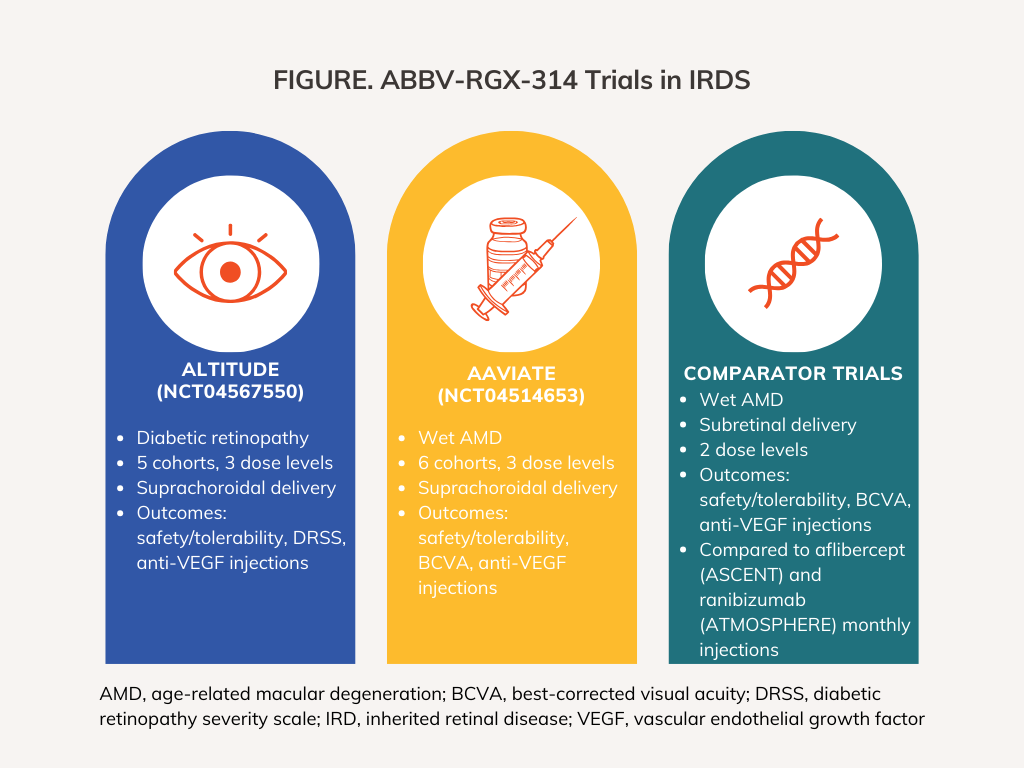REGENXBIO’s ABBV-RGX-314 Trials Aim to Reduce Treatment Burden in Inherited Retinal Diseases
The company expects that pivotal ATMOSPHERE and ASCENT trials will support a BLA filing in 2024 for wet AMD, while the AAVIATE trial evaluates the therapy in diabetic retinopathy.
REGENXBIO is taking a multipronged approach to developing its RGX-314 gene therapy for the potential treatment of inherited retinal diseases, namely wet age-related macular degeneration (AMD) and diabetic retinopathy (DR).
While anti-vascular endothelial growth factor (VEGF) injections, the current standard of care, have been shown to be efficacious in treating DR and AMD, the treatment burden of monthly injections hinders many patients from achieving long-lasting improvements in their disease in the real-world.
ABBV-RGX-314, which Abbvie has commercial rights to, is a 1-time adeno-associated virus (NAV AAV8) vector gene therapy encoding for a monoclonal antibody fragment similar to ranibizumab to express protein designed to neutralize vascular endothelial growth factor (VEGF) activity, potentially modifying the formation of new leaky blood vessels and retinal fluid accumulation.
Dilsher Dhoot, MD

“We've seen great data from previous registry trials, that providing anti-VEGF can reduce DR severity, but it turns out that the majority of these patients that have DR without vision threatening complications are not treated with anti-VEGF in the real world. This is really because of the unsustainable treatment burden of frequent injections in the eye,” Dilsher Dhoot, MD, ophthalmologist, California Retina Consultants, and adjunct clinical assistant professor, ophthalmology, Keck School of Medicine, University of Southern California, told CGTLive. “So, gene therapy allows for a 1-time in-office injection, that can potentially provide a long-lasting improvement in DR severity and thereby reduce the risk of vision threatening complications.
In patients with wet AMD, RGX-314 is being evaluated with subretinal delivery in the phase 2b/3 ATMOSPHERE trial (NCT04704921), phase 3 ASCENT trial (NCT05407636), and a phase 2 pharmacodynamic study. RGX-314 is being evaluated with suprachoroidal delivery in the phase 2 AAVIATE trial (NCT04514653) also in wet AMD. In patients with DR, RGX-314 is being evaluated with suprachoroidal delivery in the phase 2 ALTITUDE trial (NCT04567550). Data from all 3 trials were presented by investigators at the American Society of Retina Specialists (ASRS) 2023 Annual Meeting held in Seattle, Washington, in July 2023. (FIGURE.)
(Click to enlarge)

ALTITUDE Trial
The ALTITUDE trial has enrolled 60 patients aged between 25 and 89 years with moderately severe-to-severe nonproliferative or mild profilerative DR in 3 cohorts. The first cohort consists of patients negative for neutralizing antibodies (Nab-) receiving suprachoroidal delivery of 2.5 x 1011 genome copies (GC) per eye (n = 15) with an observational control group of 5 patients, the second consists of Nab- patients receiving 5.0 x 1011 GC per eye (n = 15) with an observational control group of 5 patients, and the third of Nab+ patients receiving 5.0 x 1011 GC per eye (n = 20).
The study’s primary objective is achieving a 2-step improvement on Diabetic Retinopathy Severity Scale (DRSS) at 1 year posttreatment. Secondary objectives include safety and tolerability of ABV-RGX-314, DR-related ocular complications, and improving additional standard of care interventions. The therapy was well-tolerated, with 5 serious adverse events (AEs) not related to treatment. Patients experienced some cases of mild intraocular inflammation (IOI) which resolved with topical corticosteroids. No prophylactic corticosteroids were administered. There were no meaningful differences in safety findings between Nab- and Nab+ patients.
Dhoot presented data from ALTITUDE at ASRS 2023 that showed Cohorts 1-3 had stable best-corrected visual acuity (BCVA) through 6 months.1 No patients worsened by more than 2 steps of DRSS compared with 20% in control, 20% achieved at least a 2-step improvement compared with 10% of control, and 54% achieved any DRSS improvement compared with 20% of control.1 ALTITUDE has now also enrolled 29 patients in cohorts 4 and 5 at dose level 3 of 1.0 x 1012 GC/eye with short-course prophylactic topical steroids and so far, there have been no cases of IOI.
"The findings are encouraging and RGX-314 is being well tolerated. With prophylactic steroids, we can reduce IOI to zero. We do see some scleritis, but it's controlled. It's encouraging that there's the potential for in-office injection of gene therapy to reduce the severity and ultimately reduce the risk of vision threatening complications,” Dhoot said.
AAVIATE Trial
The AAVIATE trial has enrolled 95 patients between the ages of 50 to 89 years with wet AMD in 3 dose levels of suprachoroidal delivery of ABBV-RGX-314. The first dose level of 2.5 x 1011 GC/eye is being evaluated in Nab- cohort 1 (n = 15) with a control group receiving ranibizumab (n = 5); the second dose of 5.0 x 1011 GC/eye is being evaluated in Nab-cohort 2(n = 15) with a control group receiving ranibizumab (n = 5) and in Nab+ cohort 3 (n = 20); and the third dose of 1.0 x 1012 GC/eye is being evaluated in Nab- cohort 4 (n = 15) and Nab+ cohort 5 (n = 20).
David Boyer, MD

The study’s primary objective is mean change in BCVA compared with ranibizumab monthly injection at month 9. Secondary objectives are evaluating safety and tolerability of ABBV-RGX-314, change in central retinal thickness (CRT) as measured by Spectral Domain Optical Coherence tomography (SD-OCT), and additional rescue anti-VEGF injections after gene therapy.
David Boyer, MD, senior partner, Retina Vitreous Associates Medical Group, presented the latest data at ASRS 2023 that showed that ABBV-RGX-314 was well-tolerated in the trial, with cohorts 1-3 experiencing mild IOI and cohort 4 experiencing a higher incidence of mild-to-moderate IOI.2 These cases resolved with topical corticosteroids. There were 15 serious AEs, none related to the therapy, and no meaningful differences between Nab- and Nab+ patients. Similarly to the ALTITUDE study, a new cohort (n = 10) at dose 3 receiving short-course prophylactic topical steroids has experienced no cases of IOI.
In terms of preliminary efficacy, the highest reduction in treatment burden was seen in cohort 4, which has demonstrated an 85% reduction in annualized injection rate with 67% being injection-free. Annualized injection rates decreased by 76% in cohort 1, 72% in cohort 2, and 64% in cohort 3.BCVA and CRT remained fairly stable through month 6.2
“At least for 6 months, you can maintain [visual acuity] without any additional treatment and almost 67% of patients receiving no additional therapy. We don't have very many drugs that can go 6 months, so it's very exciting."–David Boyer, MD
“It should give us pause, that we could have the ability to reduce the treatment burden to our patients safely, which is phenomenal because we have had other drugs that have been administered by various other routes that have, unfortunately, caused severe inflammation. This seems to be well-tolerated in the suprachoroidal space," Boyer told CGTLive.
Pivotal Comparator Trials – ASCENT and ATMOSPHERE
REGENXBIO initiated the pivotal ASCENT and ATMOSPHERE comparator trials for wet AMD in early 2021 and 2022, and enrollment is ongoing in these trials.3,4 Data from the 2 trials have not yet been presented. Both trials are enrolling patients between the ages of 50 and 85 years with Early Treatment Diabetic Retinopathy Study (ETDRS) BCVA letter scores between 78 and 40, a diagnosis of subfoveal choroidal neovascularization secondary to AMD in the study eye previously treated with anti-VEGF, be pseudophakic in the study eye, and have demonstrated a meaningful response to anti-VEGF. ATMOSPHERE has a target enrollment of 300 participants while ASCENT aims to enroll 465 participants.
Ashkan Abbey, MD

Both trials will evaluate 2 dose levels of ABBV-RGX-314 compared to monthly injections of aflibercept in ASCENT and ranibizumab in ATMOSPHERE. The trials share the primary outcome measure of BCVA as measured by ETDRS at week 54. Secondary measures will evaluate safety and tolerability via AEs through week 98, CRT and center point thickness as measured by SD-OCT, mean reduction in anti-VEGF injections at week 54 and 98, and aqueous RGX-314 target protein concentrations.
Texas Retina Associates is one of many trial sites enrolling patients in ATMOSPHERE and ASCENT. Ashkan Abbey, MD, serves as investigator on the studies. Abbey also presented data from the phase 2 pharmacodynamic study at ASRS 2023. The equivalency findings support the bioreactor process manufacturing for RGX-314 product being evaluated in ATMOSPHERE and ASCENT.5
“The study compared formulations developed from 2 different manufacturing processes for ABBV-RGX-314. One is a bioreactor process that would be used to manufacture the commercial product. The bioreactor process demonstrated scalability, consistent yield, and product purity. This is compared with the initial clinical research manufacturing process, known as Hyperstack,” Abbey told CGTLive. “All cohorts in the study demonstrated stable to improved BCVA and retinal thickness, and the majority of patients in all cohorts experienced significant reductions in anti-VEGF injections.”
